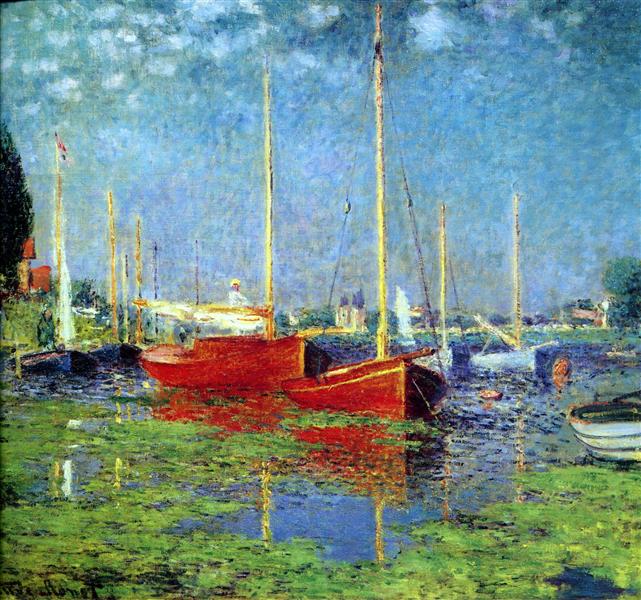Description
"Argenteuil - 1875", emblematic work of Claude Monet, encapsulates the spirit of impressionism, revealing the artist's mastery in the representation of light and movement. Painted in a moment of creative fervor, this work transports us to the quiet shore of the Sena River, in the town of Argenteuil, a place that Monet knew well and that became a recurring theme in his work. The composition is structured around the natural flow of water and the interaction of human figures with their surroundings. On the canvas anchored vessels are observed, which suggest the daily activity of river life, and scattered in space, several characters that add a sense of dynamism and humanity to the scene.
The color palette used by Monet in this work is characteristic of its style, with a mixture of soft and luminous tones that evoke a serene atmosphere. The nuances of blue, green and yellow are combined to create a vibrant light effect that seems to dance on the surface of the water. The choice of colors in this painting not only underlines the beauty of the landscape, but also reflects Monet's fascination for the changing effects of light at different times of the day. The use of loose and fast brushstrokes, a distinctive seal of impressionism, reinforces the sensation of immediacy and captures the essence of the moment, as if the viewer could almost listen to the murmur of the water and the song of the birds in the distance.
The characters found in the painting, although in large part anonymous, are representations of the middle class of the time, enjoying a day outdoors. Painted with less defined touches, they are integrated into the environment, symbolizing the harmony between the human figure and nature. This compositional choice suggests not only a sense of belonging, but also the desire to escape urban life to spaces where nature can be enjoyed and contemplated. The inclusion of these figures emphasizes Monet's interest in the representation of modern life, a recurring theme in the impressionist movement, which wanted to capture the ephemeral of human experience.
It is important to note that, although "Argenteuil - 1875" is part of the series of works that Monet dedicated to this same place, each painting is unique in its way of capturing different moments and states of light. The Sena River, as well as the activities on its margins, became a symbol of change and modernity in nineteenth -century France, a context in which Monet found a rich mine of inspiration. The technique of applying pure brushstrokes instead of mixing them in the palette confers a unique freshness to the paint, portraying not only the view, but also the atmosphere and the emotions associated with the experience of being outdoors.
"Argenteuil - 1875" not only enters the landscape and representation of everyday life; It is also a testimony of the advancement of impressionism as a movement that sought to challenge conventions, exploring new ways to see and feel the world. The work, in its apparent simplicity, reveals the complexities of human perception and the timeless connection between painting and experienced experience. As part of the evolution of Monet as an artist, this painting illustrates its growing dominance of technique and its commitment to the capture of the ephemeral beauty of the environment, a legacy that continues to resonate in contemporary art.
KUADROS ©, a famous paint on your wall.
Hand-made oil painting reproductions, with the quality of professional artists and the distinctive seal of KUADROS ©.
Reproduction service paintings With a guarantee of satisfaction. If you are not completely satisfied with the replica of your painting, we refund your money 100%.

